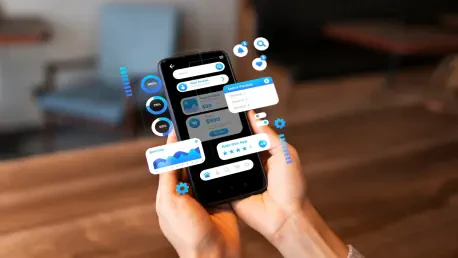Listen to the Article
74% of organizations plan to build ten or more apps in the year ahead. The need to innovate is clear. And while you might be aware of the pressure to evolve and leverage the latest in Generative AI-driven technologies for faster development—you mustn’t overlook the criticality of a solid go-to-market strategy. Mobile application success in 2025 requires more than product innovation, it demands deliberate execution across every stage of launch.
You need to ensure product-market fit, align your go-to-market timing with audience readiness, and coordinate channels with precision to drive uptake. In addition, maintaining high-intent users who convert, engage deeply, and retain over time hinges on tailored targeting strategies that prioritize value over volume.
Launching without a strategic marketing plan eliminates impact and limits reach. App visibility requires deliberate action across audience research, channel planning, and message alignment. Effective campaigns begin before product development finishes and continue long after launch. That’s why they have to be designed to drive awareness, retention, and measurable traction across all touchpoints.
To help inform your go-to-market strategy, this blog post discusses:
The need to set achievable goals and objectives.
The importance of a clearly defined, unique value proposition.
Why it might be time to move beyond the linear funnel.
Essential key performance indicators to keep an eye on.
Know Your Business Goals and Audience Needs
Every goal must be specific, measurable, and aligned with strategic growth.
Start by locking in the purpose behind the app launch with clearly defined, time-bound goals structured around real business outcomes. Focus every tactic on improving user acquisition, increasing retention, or growing revenue. Filter out vanity metrics and ground the plan in mobile marketing trends that reflect how users behave now, not how they used to. Every goal must be specific, measurable, and aligned with strategic growth.
Define your target audience precisely by identifying their habits, frustrations, and motivators so that you solve real problems rather than simply launching features. It’s also essential that you analyze your competition to pinpoint where they succeed and where they fail, and use that intelligence as your strategic edge.
By combining detailed user insights with competitive clarity, you eliminate guesswork and design a launch that delivers measurable results.
Clearly Communicate Your Unique Value Proposition
Clarify what makes your app matter by defining a specific value proposition that connects with your target audience immediately. Businesses must identify who they serve, what they need, and which pain points they eliminate faster or better than the alternatives.
You must position that core value clearly, without filler, and validate the message through direct user feedback to ensure it drives traction and holds up under scrutiny, because your unique value proposition must perform as a precision asset, not as a placeholder.
A More Flexible Framework
Customer journeys now span streaming, digital storefronts, generative interfaces, and social platforms. Each interaction opens a new opportunity to influence perception, trigger engagement, and build loyalty. Ensure you align messaging to intent, sync channels to behavior, and activate campaigns that land in the moments that drive momentum.
Securing long-term advantage requires marketers to operate on actual impact, not assumptions. Media buying must align with the channels and timing that drive real behavior change. Legacy approaches slow execution.
AI removes that drag—constantly optimizing, reacting to live signals, and automating at a speed and scale human teams can’t reach.
Tools like Marketing Cloud Engagement give you full control over every user interaction across channels. You can automate journeys based on real-time behavior, using embedded AI to increase relevance and deliver personalization at scale. Each campaign adapts as users move, and every touchpoint reinforces brand visibility. Built-in analytics track what works, surface what doesn’t, and drive faster decisions that improve performance without adding complexity.
Keep These Key Performance Indicators In-Check
From launch, your app depends on actionable metrics. Set up full-funnel tracking to capture key performance indicators and behavioral signals from the start. Prioritize data that drives iteration, not decoration. Use it to surface friction, refine strategy, and accelerate outcomes. Monitoring early ensures fast pivots and sustained traction.
Focus on metrics that drive outcomes (such as acquisition efficiency, retention patterns, engagement depth, and lifetime value) and skip surface data. Prioritize signals that reveal performance and inform action:
Time spent on the app;
Number of unique users;
Monetization income;
Revenue metrics;
Number of downloads per week/month.
Leverage Data for Personalization and Optimization
Use personalization to increase engagement and retention. Trigger notifications based on user actions. Deliver in-app messages during active sessions to promote features or capture feedback. Re-engage inactive users through email with targeted updates or incentives. Build tailored communication into every channel to extend lifetime value and reinforce loyalty.
You can do this by delivering in-app messages during active sessions to promote features or collect feedback. Moreover, use email to re-engage inactive users, highlight new updates, or deliver targeted incentives. With tailored communication across channels, you’ll be able to increase session depth, user lifetime, and conversion velocity.
Your app marketing plan must remain dynamic and responsive to data-driven insights from performance metrics. You should use analytics to identify the exact drop-off points, optimize those critical areas to boost retention, and fine-tune your ad spend by concentrating on the channels and ads that deliver the highest performance. Further, you must test different strategies and messaging through structured experiments that reveal what resonates most with your target audience, ensuring your app marketing continuously evolves to stay relevant and effective.
In Conclusion
The app market in 2025 requires a launch strategy built for impact, not surface-level momentum; with most companies releasing multiple apps, performance hinges on execution, not feature sets, which means your go-to-market plan must prioritize user retention, scalable revenue, and outcome-driven metrics from the start.
Your launch must align with actual user behavior, adapt to fragmented journeys, and integrate automation for personalization and campaign refinement; use AI to optimize delivery and iterate consistently to maximize results.
Sustained traction depends on precise targeting, disciplined execution, and a framework designed to drive growth across every touchpoint—anything less risks immediate stagnation.









